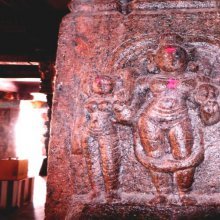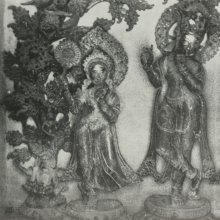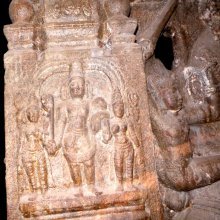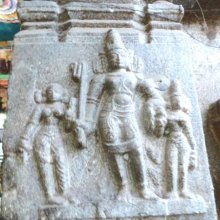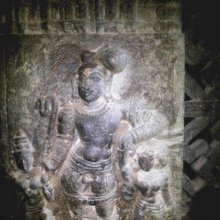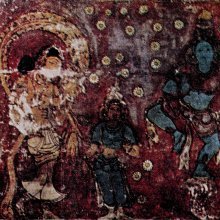Rukmini, Rukmiṇī: 15 definitions
Introduction:
Rukmini means something in Hinduism, Sanskrit, Jainism, Prakrit, the history of ancient India, biology. If you want to know the exact meaning, history, etymology or English translation of this term then check out the descriptions on this page. Add your comment or reference to a book if you want to contribute to this summary article.
Images (photo gallery)
In Hinduism
Shaivism (Shaiva philosophy)
Source: Wisdom Library: Kubjikāmata-tantraRukmiṇī (रुक्मिणी, “adorned with gold”):—One of the nine Dūtī presided over by one of the nine bhaivaravas named Yogeśa (emanation of Ananta, who is the central presiding deity of Dūtīcakra), according to the Kubjikāmata-tantra and the Ṣaṭsāhasrasaṃhitā.

Shaiva (शैव, śaiva) or Shaivism (śaivism) represents a tradition of Hinduism worshiping Shiva as the supreme being. Closely related to Shaktism, Shaiva literature includes a range of scriptures, including Tantras, while the root of this tradition may be traced back to the ancient Vedas.
Vaishnavism (Vaishava dharma)
Source: ISKCON Press: GlossaryRukmiṇī (रुक्मिणी).—Lord Kṛṣṇa’s principal queen in Dvārakā; the chief of Lord Kṛṣṇa’s wives.
Source: Pure Bhakti: Brhad BhagavatamrtamRukmiṇī (रुक्मिणी) refers to:—Śrī Kṛṣṇa’s principal queen in Dvārakā. (cf. Glossary page from Śrī Bṛhad-bhāgavatāmṛta).

Vaishnava (वैष्णव, vaiṣṇava) or vaishnavism (vaiṣṇavism) represents a tradition of Hinduism worshipping Vishnu as the supreme Lord. Similar to the Shaktism and Shaivism traditions, Vaishnavism also developed as an individual movement, famous for its exposition of the dashavatara (‘ten avatars of Vishnu’).
Purana and Itihasa (epic history)
Source: archive.org: Puranic EncyclopediaRukmiṇī (रुक्मिणी).—The chief queen of Śrī Kṛṣṇa. Birth. From the following Purāṇic statements, it could be understood that Rukmiṇī was the incarnation of goddess Lakṣmī. (See full article at Story of Rukmiṇī from the Puranic encyclopaedia by Vettam Mani)
Source: archive.org: Shiva Purana - English TranslationRukmiṇī (रुक्मिणी) refers to the “wife of Kṛṣṇa”, according to the Śivapurāṇa 2.3.19 (“Kāma’s destruction by Śiva”).—Accordingly, as Śiva said to the Gods: “O gods, O sages, all of you listen attentively to my words. What has happened, thanks to my fury, cannot be altered. The lord Kāma, the husband of Rati, shall remain bodiless till Viṣṇu incarnates as Kṛṣṇa on the earth and marries Rukmiṇī [i.e., rukmiṇīpati]. Kṛṣṇa will beget Kāma in Rukmiṇī when he goes to Dvārakā and begins to procreate children. [...]”.
Source: Cologne Digital Sanskrit Dictionaries: The Purana Index1a) Rukmiṇī (रुक्मिणी).—A daughter of Bhīṣmaka and known as Vaidarbhī. Married to Kṛṣṇa according to Gāndharva? (Rākṣasa) form;1 when she came to know of the proposal of her eldest brother Rukmi (s.v.) to give her in marriage to Caidya, she sent a letter through a Brāhmaṇa to Kṛṣṇa showing her unflinching devotion to him and requesting that she might be carried off when she would be on her way to the Devī temple on the day prior to the wedding as was the custom. That day she had her bath and decked herself with two clothes and many jewels. Her anxiety at not having heard from Kṛṣṇa, when the Brāhmaṇa came to tell her that Kṛṣṇa would do the needful. Citizens were also for her marriage with Kṛṣṇa. Well guarded and accompanied by singing and dancing, Rukmiṇī entered the temple and prayed for Kṛṣṇa's hand. After worshipping Indrāṇī nearby she returned when Kṛṣṇa carried her away in his chariot. Seeing the party of Caidya pursuing him, Rukmiṇī became nervous when Kṛṣṇa consoled her. When Caidya was about to be killed by Kṛṣṇa she appealed to the Lord to spare him; Rāma consoled her. The regular marriage and festivities followed.2 Mother of 11 sons and a daughter; gave birth to Pradyumna who was stolen by Śambara and thrown into the sea. Recovered and taken back by Māyāvatī alias Ratī; Rukmiṇī remembered her lost son and wondered at his exact resemblance. At that time came Kṛṣṇa and Nārada who explained the history of Pradyumna to her great joy;3 was the chief queen of Kṛṣṇa and more attached; would not like to be away from Kṛṣṇa; when she was once fanning him gently Kṛṣṇa cut a joke that his status was poor and that she could even then get married to a rich prince and enjoy luxuries. Rukmiṇī wept in deep distress and spoke words reiterating her full devotion to him. Kṛṣṇa consoled her assuring her of his loyalty.4 Grave concern at Kṛṣṇa not returning from the cave of Jāmbavan for a long time. Her daughter Cārumatī was married to the son of Kṛtavarman.5 Attended the marriage of Aniruddha and Rocanā at Bhojakaṭa; out of regard for her and Balarāma, Kṛṣṇa said nothing on Rukmi's death.6 Explained to Draupadī how she became married to Kṛṣṇa; welcomed to Hāstinapura by Kuntī and Draupadī; served Kucela, a friend and classmate of Kṛṣṇa.7 Entered fire on Kṛṣṇa's decease;8 is Lakṣmī.9
- 1) Bhāgavata-purāṇa III. 3. 3; X. 52. 16-18; Brahmāṇḍa-purāṇa III. 71. 242-6; Viṣṇu-purāṇa I. 9. 144; V. 26 (whole).
- 2) Bhāgavata-purāṇa X. Chh. 52-54.
- 3) Ib. III. 1. 28; X. 55 (whole) ; Matsya-purāṇa 47. 13, 15-16; Vāyu-purāṇa 96. 233; Viṣṇu-purāṇa V. 27. 3, 27; 28. 1-2; 30. 35; 32. 1.
- 4) Bhāgavata-purāṇa X. 60 (whole) ; 70. 3; 90. 30.
- 5) Ib. X. 56. 34; 61. 24.
- 6) Ib. X. 61. 26-39.
- 7) Ib. X. 71. 42; 76. 2; 80. 23; 83. 8.
- 8) Ib. XI. 31. 20. Viṣṇu-purāṇa V. 38. 1-2.
- 9) Ib. IV. 15. 35.
1b) The goddess at Dvāravatī.*
- * Matsya-purāṇa 13. 38.

The Purana (पुराण, purāṇas) refers to Sanskrit literature preserving ancient India’s vast cultural history, including historical legends, religious ceremonies, various arts and sciences. The eighteen mahapuranas total over 400,000 shlokas (metrical couplets) and date to at least several centuries BCE.
Ayurveda (science of life)
Nighantu (Synonyms and Characteristics of Drugs and technical terms)
Source: WorldCat: Rāj nighaṇṭuRukmiṇī (रुक्मिणी) is another name for Svarṇakṣīrī, an unidentified medicinal plant, according to verse 5.55-56 of the 13th-century Raj Nighantu or Rājanighaṇṭu. The fifth chapter (parpaṭādi-varga) of this book enumerates sixty varieties of smaller plants (kṣudra-kṣupa). Together with the names Rukmiṇī and Svarṇakṣīrī, there are a total of eight Sanskrit synonyms identified for this plant.

Āyurveda (आयुर्वेद, ayurveda) is a branch of Indian science dealing with medicine, herbalism, taxology, anatomy, surgery, alchemy and related topics. Traditional practice of Āyurveda in ancient India dates back to at least the first millenium BC. Literature is commonly written in Sanskrit using various poetic metres.
Kavya (poetry)
Source: OpenEdition books: Vividhatīrthakalpaḥ (Kāvya)Rukmiṇī (रुक्मिणी) is the daughter of the merchant Dhana, as mentioned in the Vividhatīrthakalpa by Jinaprabhasūri (13th century A.D.): an ancient text devoted to various Jaina holy places (tīrthas).—Accordingly, “Rukmiṇī has longed to become the wife of Master Vajra since the day she heard the nuns sing his praises. As a result, when the Master comes to Pāṭaliputra, the merchant Dhana, father of Rukmiṇī, offers Vajra his daughter and a considerable dowry. The Master declines the offer and converts Rukmiṇī to Jainism”.
Cf. Pariśistaparvan (or Sthavirāvalīcarita) XII. v. 292-306.

Kavya (काव्य, kavya) refers to Sanskrit poetry, a popular ancient Indian tradition of literature. There have been many Sanskrit poets over the ages, hailing from ancient India and beyond. This topic includes mahakavya, or ‘epic poetry’ and natya, or ‘dramatic poetry’.
General definition (in Hinduism)
Source: Apam Napat: Indian MythologyRukmini was the daughter of King Bhishmaka, the ruler of the Bhoja Kingdom. She had fallen in love with Krishna after having heard his heroic exploits, but her brother, prince Rukmi, was desirous of marrying her to his friend, King Shishupala of Chedi.
She is the mother of Pradyumna.
Source: WikiPedia: HinduismRukmiṇī (रुक्मिणी): Daughter of Raja Bhismak, born at Kundalpur. Rukmini was the first wife and queen of Krishna, the 8th avatar of Vishnu. She was an avatar of Lakshmi.
In Jainism
General definition (in Jainism)
Source: academia.edu: Tessitori Collection I1) Rukmiṇī (रुक्मिणी) refers to one of the “sixteen virtuous Jain women”, according to the “Sola satyā” (dealing with the lives of Jain female heroes), which is included in the collection of manuscripts at the ‘Vincenzo Joppi’ library, collected by Luigi Pio Tessitori during his visit to Rajasthan between 1914 and 1919.—There is a list of sixteen virtuous Jain women. [...] These women [e.g., Rukmiṇī] are virtuous because they uphold Jain values and could stand to them even in adverse circumstances. Reciting their names is often part of the morning ritual. Behind names are eventful stories that have been told by several writers and read or listened to by Jain followers.
2) Rukmiṇī (रुक्मिणी) married Kṛṣṇa, according to the Vedabhīvīvāha by Premarāja.—Background story:—Vedabhī, Sanskrit: Vaidarbhī, here refers to Rukmiṇī, who married Kṛṣṇa. all the figures evoked in this narrative poem are contemporary with Neminātha and Kṛṣṇa. Among them Satyabhāmā, who is Rukmiṇī’s rival, is present.

Jainism is an Indian religion of Dharma whose doctrine revolves around harmlessness (ahimsa) towards every living being. The two major branches (Digambara and Svetambara) of Jainism stimulate self-control (or, shramana, ‘self-reliance’) and spiritual development through a path of peace for the soul to progess to the ultimate goal.
India history and geography
Source: Shodhganga: a concise history of Sanskrit Chanda literature (history)Rukmiṇī (रुक्मिणी) is the mother of Gaṅgādharakavi (19th century): author of Vṛttacandrikā and disciple of Viśvanātha, the brother of Candraśekhara. Gaṅgādharakavi was born in a Mahārāṣṭra Brahmin family and migrated to Nagpur from Maṅgrūl village in Buldana district of Berar. He was the contemporary of king Raghujī III and his successor Jānojī. Gaṅgādharakavi composed 14 works and commentaries in Sanskrit. Vṛttacandrikā is the lone work on Prosody.

The history of India traces the identification of countries, villages, towns and other regions of India, as well as mythology, zoology, royal dynasties, rulers, tribes, local festivities and traditions and regional languages. Ancient India enjoyed religious freedom and encourages the path of Dharma, a concept common to Buddhism, Hinduism, and Jainism.
Biology (plants and animals)
Source: Google Books: CRC World Dictionary (Regional names)Rukmini in India is the name of a plant defined with Argemone mexicana in various botanical sources. This page contains potential references in Ayurveda, modern medicine, and other folk traditions or local practices It has the synonym Echtrus mexicanus (L.) Nieuwl. (among others).
Example references for further research on medicinal uses or toxicity (see latin names for full list):
· Flora Cochinchinensis (1790)
· Edwards’s Botanical Register
· Species Plantarum (1753)
· Journal of Botany, British and Foreign (1895)
· Hortus Britannicus (1830)
· Mem. Torrey Bot. Club (1958)
If you are looking for specific details regarding Rukmini, for example diet and recipes, pregnancy safety, side effects, extract dosage, health benefits, chemical composition, have a look at these references.

This sections includes definitions from the five kingdoms of living things: Animals, Plants, Fungi, Protists and Monera. It will include both the official binomial nomenclature (scientific names usually in Latin) as well as regional spellings and variants.
Languages of India and abroad
Sanskrit dictionary
Source: DDSA: The practical Sanskrit-English dictionaryRukmiṇī (रुक्मिणी).—The daughter of Bhīṣmaka of Vidarbha. [She was betrothed by her father to Śiśupāla, but she secretly loved Kṛṣṇa and sent him a letter praying him to take her away. Kṛṣṇa with Balarāma came and snatched her off after having defeated her brother in battle. She bore to Kṛṣṇa a son named Pradyumna.].
Source: Cologne Digital Sanskrit Dictionaries: Monier-Williams Sanskrit-English Dictionary1) Rukmiṇī (रुक्मिणी):—[from ruc] a f. (of rukmin) a species of plant (= svarṇa-kṣīrī), [cf. Lexicographers, esp. such as amarasiṃha, halāyudha, hemacandra, etc.]
2) [v.s. ...] Name of a daughter of Bhīṣmaka and sister of Rukmin (betrothed by her father to Śiśu-pāla but a secret lover of Kṛṣṇa, who, assisted by Bala-rāma, carried her off after defeating her brother in battle; she is represented as mother of Pradyumna, and in later mythology is identified with Lakṣmī), [Mahābhārata; Kāvya literature; Purāṇa]
3) [v.s. ...] Name of Dākṣāyaṇī in Dvāravatī, [Catalogue(s)]
4) [v.s. ...] of various other women, [Hemacandra’s Pariśiṣṭaparvan]
5) [from rukmin > ruc] b f. See above.
Sanskrit, also spelled संस्कृतम् (saṃskṛtam), is an ancient language of India commonly seen as the grandmother of the Indo-European language family (even English!). Closely allied with Prakrit and Pali, Sanskrit is more exhaustive in both grammar and terms and has the most extensive collection of literature in the world, greatly surpassing its sister-languages Greek and Latin.
See also (Relevant definitions)
Starts with: Rukminicampu, Rukminiharana, Rukminihrada, Rukminikalyana, Rukminikalyanacarita, Rukminikalyanacharita, Rukminikrishnavalli, Rukminikunda, Rukmininandana, Rukmininataka, Rukminiparinaya, Rukminipati, Rukminisha, Rukminishavijaya, Rukminisvayamvara, Rukminisvayavara, Rukminitirtha, Rukminivilasa, Rukminivivaha, Rukminivrata.
Full-text (+126): Bhishmaka, Pradyumna, Carugupta, Carudeshna, Raukmineya, Sucaru, Bhaishmaki, Bhaishmaka, Vicaru, Rukmin, Vaidarbhi, Kamasu, Yashovara, Vidarbhaja, Hemabha, Rukmininataka, Rukmi, Rukminiharana, Rukminikalyana, Rukminicampu.
Relevant text
Search found 52 books and stories containing Rukmini, Rukmiṇī; (plurals include: Rukminis, Rukmiṇīs). You can also click to the full overview containing English textual excerpts. Below are direct links for the most relevant articles:
Garga Samhita (English) (by Danavir Goswami)
Verse 6.8.16 < [Chapter 8 - The Marriages of All the Queens]
Verse 6.7.43 < [Chapter 7 - The Marriage of Śrī Rukmiṇī]
Verse 6.6.24 < [Chapter 6 - The Yādavas’ Victory When Śrī Rukmiṇī is Kidnapped]
Sahitya-kaumudi by Baladeva Vidyabhushana (by Gaurapada Dāsa)
Text 7.78 < [Chapter 7 - Literary Faults]
Text 7.28 < [Chapter 7 - Literary Faults]
Text 11.10 < [Chapter 11 - Additional Ornaments]
Dasarupaka (critical study) (by Anuru Ranjan Mishra)
Part 7 - Characters in the Rukmiṇīharaṇa < [Chapter 9 - Īhāmṛga (critical study)]
Part 2 - Summary of the drama (Rukmiṇīharaṇa) < [Chapter 9 - Īhāmṛga (critical study)]
Part 9 - Sentiments (rasa) used in a Īhāmṛga < [Chapter 9 - Īhāmṛga (critical study)]
Song 3 < [Grantharambha (the book begins)]
Song 4 < [Grantharambha (the book begins)]
Song 1 < [Grantharambha (the book begins)]
The “Rukminiparinaya” < [April – June, 1987]
Pilgrimage to Beauty < [July – September, 1986]
The Parijata of Love < [July-August, 1929]
Related products
